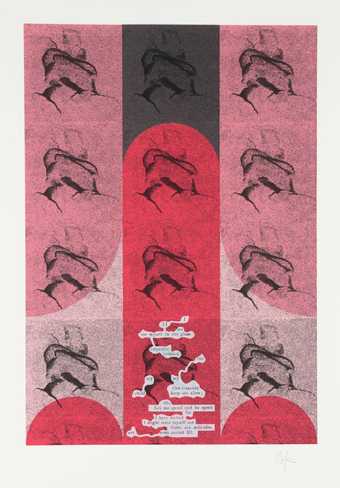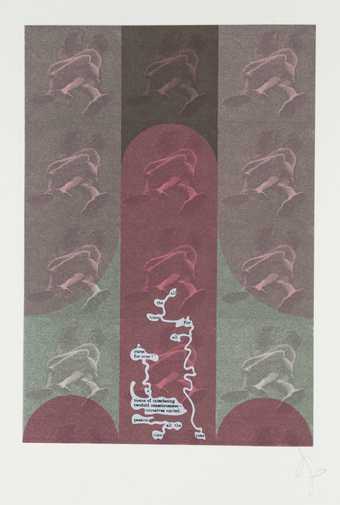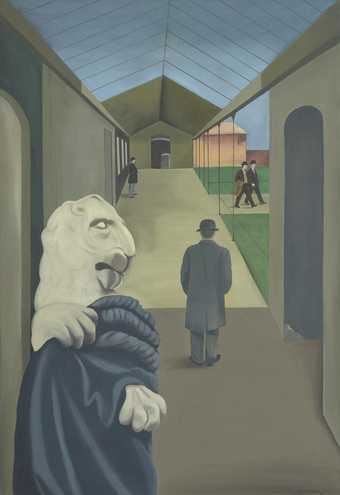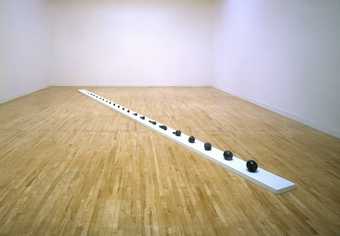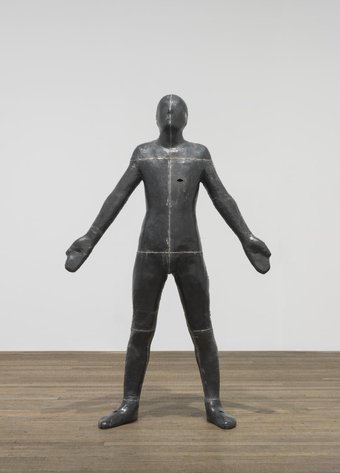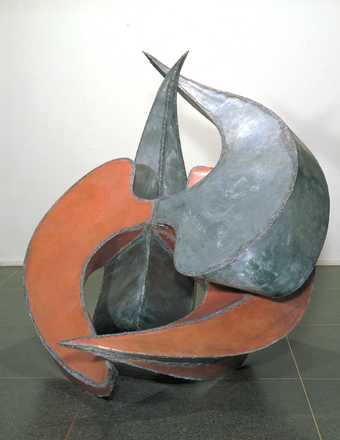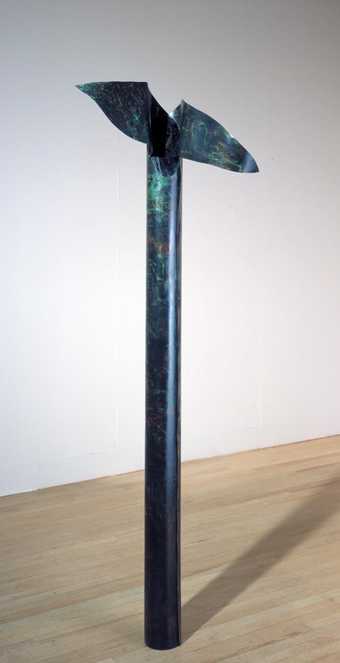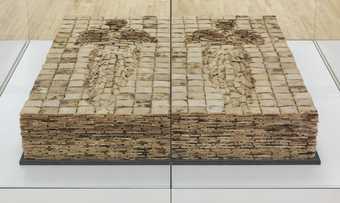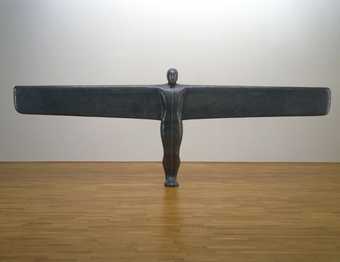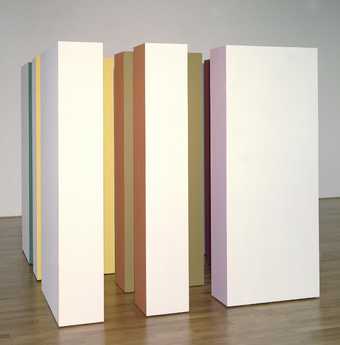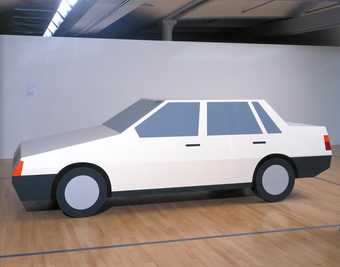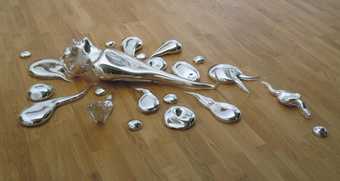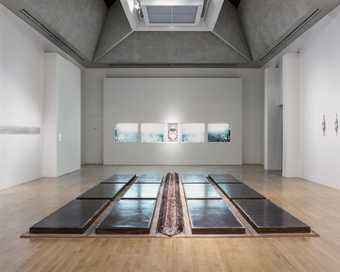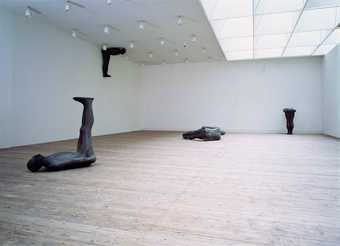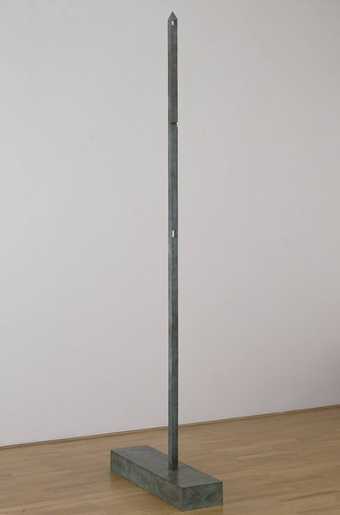
Not on display
- Artist
- Sir Antony Gormley OBE RA born 1950
- Medium
- Lead and plaster
- Dimensions
- Object: 620 × 995 × 510 mm, 90 kg
object: 625 × 1230 × 800 mm, 110 kg
object: 310 × 2110 × 570 mm, 110 kg - Collection
- Tate
- Acquisition
- Purchased 1995
- Reference
- T07015
Summary
Three Ways: Mould, Hole and Passage is one of the earliest pieces Gormley made using casts taken from his own body. It utilises three simple body poses, each one reproduced in the form of a simplified figure, cast in lead. As its title indicates, Three Ways is linked to processes of making and penetrating a body, but also represents functions of perception and awareness. Gormley uses his own body as the starting point to express universal human experience. For him, the body as the container or seat of consciousness becomes the means of articulating the unknowable and unseeable. He has described his casting process:
I adopt the position which I have selected for a sculpture and am wrapped in scrim and plaster. Because the plaster dries quickly, within ten minutes, the work is divided in different sections The whole process takes about an hour, perhaps an hour and a half. Then I am cut out of my mould and it is reassembled.You are aware that there is a transition, that something that is happening within you is gradually registering externally I concentrate very hard on maintaining my position and the form comes from this concentration.
(Quoted in Anthony Gormley, pp.19-20.)
After adjusting the form of the reassembled mould, Gormley strengthens it with a layer of fibreglass. A layer of roofing lead is then beaten over the contours of the mould, creating a skin which encases an enlarged version of his body. The lead is welded at the joining points and, in Three Ways, along the axes of the limbs. In most of his subsequent metal cases, the soldering lines follow the axes of horizontal and vertical, connecting the organic form of the body with the geometric grid.
The poses in Three Ways relate on a formal level to a sphere, a pyramid and a line. Mould is the body curled tight into a ball and balanced on its back; Hole presents the body in a vulnerable position bent over on itself, upside down; Passage represents a state at once calm and aroused, as the figure lies flat on its back with an erect penis. The figures have been penetrated at the mouth, the anus and the penis respectively, points which occur at the vertical apex of each sculpture. Breaking the seemingly impenetrable surface of the lead body cases, the orifices suggest a possibility for interaction between the outside world and the hollow space enclosed within. For Gormley, three is the 'beginning of infinity' (Hutchinson, p.53), leading to the multiple possibilities of spiritual awakening or resurrection. The possibility for this is suggested in Three Ways in the symbolic erection of the Passage figure. Hutchinson has noted that this figure echoes ancient Egyptian resurrection imagery in the Tomb of Sethi the First in the Valley of the Kings, Luxor, where the rebirth of the sun god is depicted by an icthyphallic man lying on his back with an erect phallus (Hutchinson, p.55). Three Ways may offer an allegory for the processes of a physical life from birth to death (with the possibility of a spiritual re-birth to come), as a human being is first moulded into concrete form, then is opened to interaction with his external world, and finally passes back into the clay from which he was formed. By using the body as a means to delineate an imaginative space as a suggestion of inner potential, it also operates on the level of a spiritual becoming.
Further reading:
John Hutchinson, E.H. Gombrich, Lela B. Njatin, Antony Gormley, London 2000, p.55, reproduced p.110
Gormley: Theweleit, exhibition catalogue, Schleswig-Holsteinischer Kunstverein, Schleswig-Holstein 1999
Antony Gormley, exhibition catalogue, Konsthall Malmö, Malmö 1993, pp.19-20, reproduced p.19
Elizabeth Manchester
March 2000
Does this text contain inaccurate information or language that you feel we should improve or change? We would like to hear from you.
Display caption
'You are aware that there is a transition, that something that is happening within you is gradually registering externally.' This is how Antony Gormley described his experience of making plaster casts of his own body. For Three Ways he used such casts to make lead figures in three simple poses: curled into a ball, bending over and lying down.
The sculptures have holes at the mouth, anus and penis respectively. These break the seemingly impenetrable surface of
the lead body cases, suggesting an interaction between the outside world and the hollow space enclosed within.
Gallery label, August 2004
Does this text contain inaccurate information or language that you feel we should improve or change? We would like to hear from you.
Explore
- abstraction(8,615)
-
- from recognisable sources(3,634)
-
- figure(2,270)
- formal qualities(12,454)
-
- space(177)
- transformation(186)
- actions: postures and motions(9,111)
-
- arms folded(137)
- leg / legs raised(85)
- lying down(392)
- man(10,453)
- orifice(10)
- sexual organs(178)
- group(4,227)
- Judaeo-Christian imagery(856)
-
- resurrection(30)
- spirituality(739)
- sex and relationships(833)
-
- sex(557)
You might like
-
Tom Phillips Canto XV: [no title]
1981 -
Tom Phillips Canto V: [no title]
1981 -
Conroy Maddox Passage de l’Opéra
1970–1 -
Sir Antony Gormley OBE RA Natural Selection
1981 -
Sir Antony Gormley OBE RA Untitled (for Francis)
1985 -
Shirazeh Houshiary The Earth is an Angel
1987 -
Alison Wilding OBE Locust
1983 -
Sir Antony Gormley OBE RA Bed
1980–1 -
Sir Antony Gormley OBE RA A Case for an Angel III
1990 -
Julian Opie It Is Believed That Some Dinosaurs Could Run Faster Than a Cheetah
1991 -
Julian Opie You are driving a Volvo
1996 -
Marc Quinn The Etymology of Morphology
1996 -
Cathy De Monchaux Never forget the power of tears
1997 -
Sir Antony Gormley OBE RA Testing a World View
1993 -
Bob Law Tall Obelisk with Two Holes and a Notch
1981

